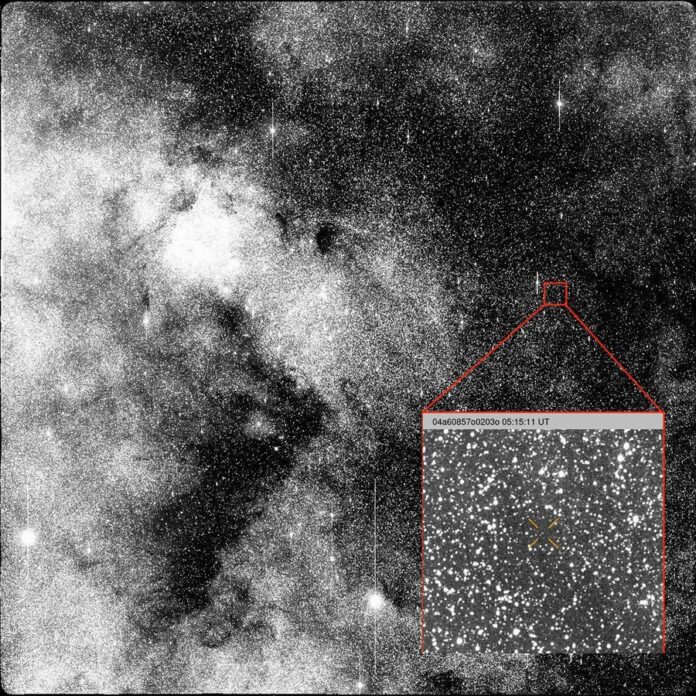
Key Insights
- One day from now (Oct. 29–30, 2025), interstellar visitor 3I/ATLAS skirts behind the Sun and begins to re-emerge, offering the first clean look since conjunction.
- NASA’s broader Strategy for Planetary Defense—formalized with the U.S. government’s national plan—continues in “activated” implementation mode, including detection, characterization, and mitigation.
- The International Asteroid Warning Network has queued a community astrometry campaign that explicitly targets 3I/ATLAS, signaling how seriously the observing world is taking this object.
By Samuel Lopez | USA Herald
USA HERALD – If you’ve been following our coverage, you already know why people are buzzing. 3I/ATLAS—only the third confirmed interstellar visitor—was discovered July 1, 2025, and is now swinging through the inner solar system. Perihelion is expected around Oct. 29-30 (about 1.4 AU from the Sun).
NASA’s Planetary Defense Coordination Office runs on a standing Strategy and Action Plan—think of it as the playbook that keeps telescopes, analysts, and mission teams synced so that when something unusual shows up, the system is already humming.
That framework—paired with the White House’s national preparedness plan—covers the full spectrum from finding objects to, if ever necessary, nudging one off course (DART proved that play is real). With 3I/ATLAS in the headlines, what you’re seeing is that plan operating in real-time: targeted observing campaigns, and cross-agency coordination. Planetary Defense at NASA
We’ve also reported on a widely shared interview with Dr. Michio Kaku—his “bingo” test: if 3I/ATLAS were to pick up excess energy at perihelion beyond what physics predicts, that would be a tell for intelligent guidance.
That’s a provocative yardstick, and our job is to keep it grounded: ordinary gravitational mechanics (e.g., the Oberth effect) already allow energy changes near the Sun, so any “excess” would need careful, peer-reviewed proof. Still, the quote captures the public’s curiosity, and curiosity is healthy—just pair it with good data. USA Herald – The People’s Voice
So, what exactly is “activated” now? For the next stretch, observers will chase precise position measurements (astrometry) to tighten trajectory fits; spectroscopy and imaging to probe the coma and any weirdness; and coordinated reporting through IAU/Minor Planet Center and IAWN channels.
That’s not a new switch so much as a surge of focused activity under the existing Plan. On the hardware horizon, NASA’s NEO Surveyor—now past critical design review and slated to launch no earlier than 2027—will massively accelerate discovery and tracking of faint, dark objects from space, complementing today’s ground telescopes. NASA-Finding asteroids before they find us.
For our readers: step outside and look up this week. No doom, no hype—just a rare chance to watch science do its thing in real time. If 3I/ATLAS behaves like a normal comet, that’s a win for understanding the stuff between the stars. If it throws us a curveball, we’ll have the instruments, the plan, and the scrutiny to catch it.
What’s Next
— Oct. 29–30, 2025: Re-emergence and perihelion window. Analysts will compare measured velocities with model predictions; any claims of “excess energy” will be tested against standard dynamics. NASA Science
— Nov 2025–Jan 2026: IAWN Comet Astrometry Campaign on 3I/ATLAS: community observations to refine orbit, coma behavior, and non-gravitational effects. Expect incremental MPC circulars and updated solutions.
Editor’s note: We’ll keep our readers updated as hard numbers arrive. Until then—clear skies, and don’t forget to look up.
Sources
— NASA overview: Comet 3I/ATLAS (perihelion timing, distance). NASA Science
— NASA: Strategy for Planetary Defense (agency plan). NASA Science
— NASA OIG report: implementation status of Planetary Defense Strategy (goals/action items). NASA Office of Inspector General
— White House/OSTP: National Preparedness Strategy & Action Plan for NEO Hazards (national framework). The White House
— IAWN campaigns: 3I/ATLAS Comet Astrometry (Nov 2025–Jan 2026). IAWN
— Our prior reporting on the Kaku “excess energy” test. USA Herald – The People’s Voice


